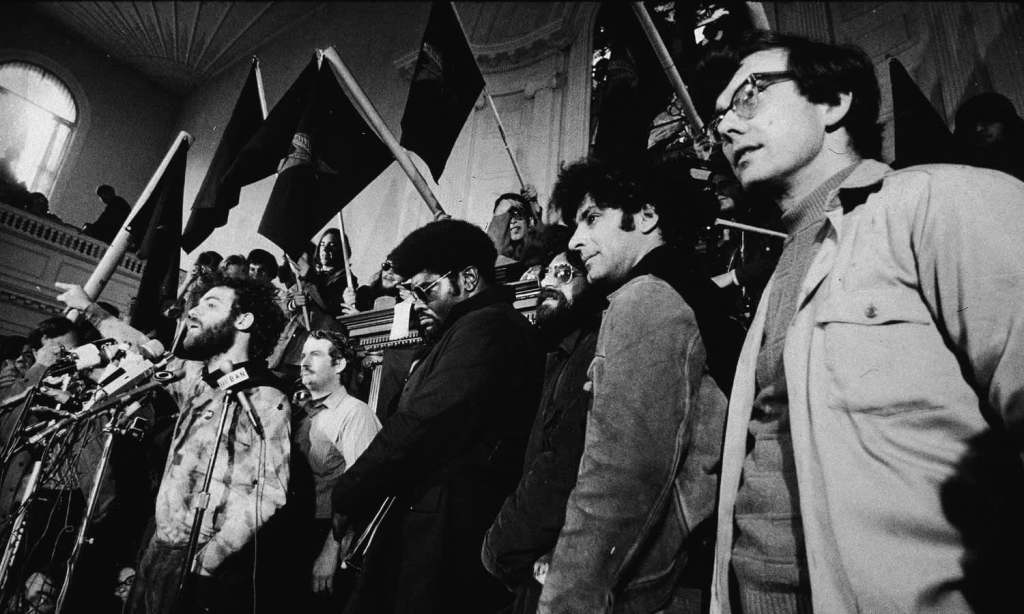In 1968, a riot broke out at the 1968 Democratic National Convention in Chicago. A group of seven (originally eight) activists were arrested for their radical political views resulting in one of the most gripping court cases in US history.
Now, a film, written and directed by Aaron Sorkin (The West Wing), is seeing a release on Netflix and has already been dubbed so powerful that it has been tipped to win an Oscar.
The film’s cast includes Sacha Baron Cohen (Borat), Joseph Gordon-Levitt (Inception), Michael Keaton (Birdman), Alex Sharp (The Hustle), Frank Langella (Frost/Nixon), Daniel Flaherty (The Wolf of Wall Street), Jeremy Strong (The Big Short), Eddie Redmayne (Les Miserables), John Carroll Lynch (The Founder), Mark Rylance (Bridge of Spies) and Noah Robbins (Grease Live).
Premiering in Australia on October 16, the film follows the true story of Abbie Hoffman (Baron Cohen), Jerry Rubin (Strong), David Dellinger (Lynch), Tom Hayden (Redmayne), Rennie Davis (Sharp), John Froines (Flaherty), and Lee Weiner (Robbins), who were charged by the US federal government with conspiracy, inciting to riot, and other charges related to anti-Vietnam War and countercultural protests.
The film follows the 1987 made-for-television movie which starred Peter Boyle, Elliot Gould, Martin Sheen and Ron Rifkin.
What happened to the Chicago 7?
In August 1968, a Democratic National Convention was held in Chicago at the International Amphitheatre. Before the actual convention, a slew of rallies, demonstrations and marches took place approximately eight kilometres away in protest of President Lyndon B Johnson’s policies for the Vietnam War.
At the time, demonstrators had petitioned to legally be able to hold the rallies and camp at Lincoln Park, however, the city denied all permits — except on at Bandshell in Grant Park — while also enforcing an 11.00 pm curfew.
On August 28, 15,000 protestors attended the rally at Grant Park, with hundreds of thousands of protesters attending nearby. Afterwards, thousands attempted to march to the amphitheater but were stopped by police who used tear gas and verbal and physical force to stop them.
News cameras caught the protests on camera, and several arrests were made — including that of the Chicago Seven. The scene was later called a “police riot” by the U.S. National Commission on the Causes and Prevention of Violence.
In an interview with The Guardian, Rennie Davis, now 80, spoke about the experience.
“Our initial plan was to bring 500,000 people to Chicago and it was simply because the mayor refused to grant permits that the numbers reduced, but the result was a police riot. That’s how a presidential commission defined what happened. But it was watched on television by more people than watched the moment the first man landed on the moon. It was incredible.”
On September 9, a Federal Grand Jury came together to consider criminal charges against eight demonstrators and eight police officers. They were task with finding guilt of conspiracy by protesters to cross state lines to incite a riot, violations by police of the civil rights of demonstrators by use of excessive force, TV network violations of the Federal Communications Act and TV network violations of federal wiretap laws.
Over six months, 200 witnesses were heard and even the Attorney General, Ramsey Clark, said that the protestors should not be charged due to “mishandling of the protests by the Chicago police.”
Outside the courtroom, demonstrations increased and eight protestors became seven when according to The Chicago Tribune, Seale “after loudly disrupting the trial when he could not have the lawyer of his choice, was at first bound and gagged in the courtroom and then severed from the case for a later trial, which never occurred.” For several days, he would appear in court bound and gagged.
Defendants Hoffman and Rubin — who were members of the Youth International Party (Yippies) — also mocked the courtroom, even appearing in court in judicial robes. After being asked to remove them, they complied only to be wearing Police Uniforms underneath.
After months of national news coverage and outrage, on March 20, 1969, the men and police officers were charged with various crimes.
Judge Julius Hoffman cited the men (and their lawyers) for contempt, handing out various sentences ranging from two-and-a-half months to four years.
On February 18, 1970, the seven defendants were acquitted of conspiracy, with two (Froines and Weiner) let go completely and the others convicted of crossing state lines “with the intent to incite a riot”. Two days later they were sentenced to five years in prison and fined $5,000 each.
On November 21, 1972, all of the convictions were overturned by the United States Court of Appeals for the Seventh Circuit on the basis that the judge was biased.
WATCH: The official trailer for The Trial of the Chicago 7.
Read more stories from TheLatch— and follow us on Facebook.

